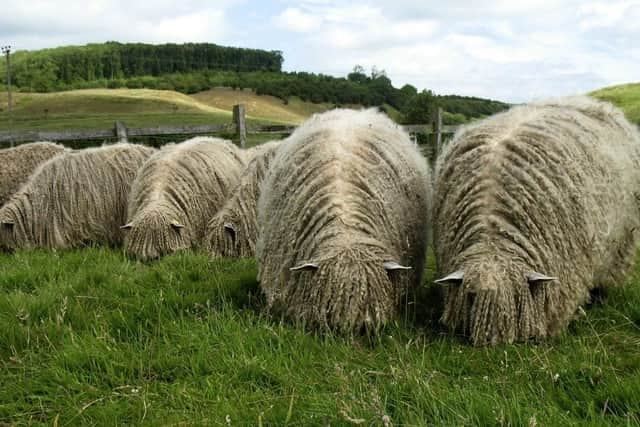Farm of the Week: Introducing the Fairburns and their prolific Great Yorkshire Show breed champions


Without wanting to put the hex on Louise’s aspirations, if the couple were successful again it would provide their tenth consecutive breed championship at Harrogate.
Louise was never destined for life in the sheep rings. Born in Yorkshire, coming from Hatfield near Doncaster she studied ergonomics at university in Loughborough and set up a consultancy that saw her working with everyone from binmen to librarians. She and Ian now run Foxhall Plant Hire in Louth.Eventually she made a lifestyle choice to swap city for country.
Advertisement
Hide AdAdvertisement
Hide Ad“In my early 30s I took on Risby Grange near Walesby, close to Market Rasen on the north-west scarp of the Lincolnshire Wolds. It was quite a big renovation project. I met my future husband Ian about 15 years ago when he came to put down what we now call our ‘long and winding road’ that leads up from the lane to our house.


“The land runs to 50 acres with most of it on an incline and it was Ian’s idea that we should put sheep on to tend the grass as he’d had enough of trying to keep on top of it with a quad topper. Cattle were grazing it previously but because springs come up through the chalk bed they were a bit too heavy and would poach it.
“We took a trip to Louth Cattle Market to take a look at what might be available and Ian, who had arrived before me, said he’d seen these really fantastic sheep but didn’t know what they were. I thought they were Lincoln Longwools but we didn’t dive in straight away. If we were going to have sheep it made sense to have something that was interesting. I contacted the breed society based at Lincolnshire Showground and received wonderful advice and encouragement from the breed secretary at the time Lorna Newboult. She and her husband Terry have been great friends for many years.”
Advertisement
Hide AdAdvertisement
Hide AdBuoyed by the support they were receiving and keen to get started Louise and Ian headed for Heckington Show near Sleaford, billed as the largest village show in England, and the home of the Lincoln Longwool, where it hosts the breed society show and sale.
“We were committed to expenditure on the house and so we didn’t have lots of spare money, but we wanted to get started. We gave ourselves a budget of £600 and decided our aim was to buy as many Lincoln Longwool sheep as we could. I wouldn’t advise anyone now to do it the way we did. Today to anyone new, I would say buy the best you can even if it means bringing just three home. We bought six and they were a right ropey bunch. Not only that but we soon realised our ewes wouldn’t provide us with anything other than wool if we didn’t invest in a tup. We purchased a ram lamb and we were under way.
“The following spring we had nine lambs but only three were ewe lambs. I rang Ron Hilton, now a fabulous supporter of the breed, and asked whether his four really good gimmer ewes I knew about by then were available and that gave us our proper start with quality stock.
Advertisement
Hide AdAdvertisement
Hide Ad“When our own lambs were born from these ewes Ian said he thought we should be showing them. Talking me into having sheep was one thing, wearing a white coat was quite another.”
Louise found herself immersed in the showing world from day one and has since become Lincoln Longwool Sheep Breeders Association chairperson, a post she has held for some seven years after previously being vice-chairman.
‘We tried that first crop of good lambs at Heckington Show. It was our first show and we knew nothing but everyone was really friendly. When we were stood at the wrong end of the line in each class my competitive streak came out. I asked the judge Geoff Smith what was wrong with our sheep, because we were quite new to the showing world, and he said there was nothing wrong with them. He also asked when they had been born. When I told him April he just looked at me and said ‘you don’t have show lambs born in April, you have them in January’. Ours were too small that was all.”
Advertisement
Hide AdAdvertisement
Hide AdFrom that day on the Fairburns began getting their act together. They received further great help from breeder and previous breed vice-chairman –now sadly passed – Maurice Parker that brought about a third place at Lincolnshire Show and breed championships have come their way at many shows including a reserve Interbreed championship at Three Counties Show in Malvern.
“They had a ewe, Countess, who was Longwool Interbreed Champion at the Great Yorkshire Show in 2016.
“It’s pretty hard for a Lincoln Longwool to take the Longwool Interbreed title against Teeswaters, Leicesters and Wensleydales but we were in the final four for the Great Yorkshire Show Supreme Champion.”
Behind their ongoing successes is another story.
Louise and Ian have 50 breeding ewes and at least 70 stock, but there are dwindling numbers of Lincoln Longwool sheep.
Advertisement
Hide AdAdvertisement
Hide Ad“The breed is on the endangered list in common with other British longwool natives.
“That’s why it is so important to encourage others to come into the breed as Ian and I did. It is still a good dual-purpose breed that has its place.”
She adds: “At present there are less than 800 registered breeding ewes in the UK with around 90 per cent of the breed in Lincolnshire.
‘It’s a frightening statistic and with only 60 registered flocks from which only half are active in registering there is a very real danger that, heaven forbid, another foot-and-mouth epidemic occurred and Lincolnshire was in a cull zone the breed could be wiped out."